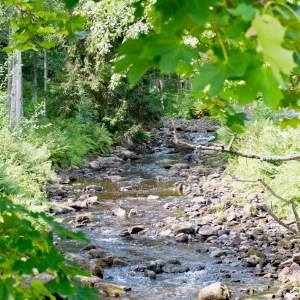Contact
Department of Aquatic Sciences and Assessment, Division of Ecology and Biodiversity

Microplastics that enter lakes and streams could affect the growth and survival of organisms, and have negative effects on biodiversity and key ecosystem processes.
The impacts of microplastics have been studied most extensively in marine ecosystems, but there has been relatively little focus on the behaviour and impacts of microplastics in freshwater ecosystems. The aim of this project it to addresses key gaps in the understanding of the behaviour of different types of microplastics in streams, providing managers and policy makers with a base for effective management, policy and governance strategies for eliminating or reducing the impact of microplastics in freshwater ecosystems.
State-of-the-art facilities in Norway and Germany will be used to run whole channel experiments, whereas the world-leading Phytotron controlled environment facility at SLU Uppsala will be used for microcosm experiments.
The aim of the project is to:
More specifically, the following research questions will be addressed:
Concern about the environmental impacts of microplastics and their implications for human health and wellbeing has never been higher. Unfortunately, growth in the empirical understanding of the dynamics and ecological and health impacts of microplastics lags behind. This hinders the capacity of scientists, managers and policy makers to address public concerns about the true level of risk posed by MPs (e.g. to the environment and to the human food chain), and to develop effective management, policy and governance strategies for eliminating or reducing those risks. Such action is urgently needed for the protection of aquatic ecosystems in particular, where microplastics accumulation is worryingly high (Claessens, et al. 2013; Free, et al. 2014).
Vast quantities of plastic waste enter aquatic ecosystems primarily via terrestrial runoff (e.g. storm water from urban and industrial areas where plastic use is high), wastewater or windthrow. Some of this plastic waste, known as “primary microplastics”, is already in microplastic form (particle ø ≤ 5 mm), premanufactured as beads, fibres or other shapes. Additionally, larger plastic waste particles can be reduced down to microparticle size, due to physicochemical- (including photo- and mechanical degradation) and biodegradation processes, and is then known as “secondary microplastics”.
The impacts of microplastics have been studied most extensively in marine ecosystems, focussing especially on fish, reflecting the importance of marine fisheries in human food supply. Documented impacts include interruption of dietary processes, growth and metabolism (e.g. increased energy expenditure, reduced growth) and altered neurological and genetic function. Microplastics also interact with other stressors, particularly chemical stressors (e.g. by binding toxins, which may increase toxin transport and uptake into the food web) and can increase biofouling (by acting as substrates for excessive biofilm development, and forming aggregates with algal or bacterial cells).
In contrast, there has been relatively little focus on the behaviour and impacts of microplastics in freshwater ecosystems. This is despite the vulnerability of freshwaters to inputs of plastic waste, especially via storm water and other terrestrial runoff, and the potential of stream and river networks to act as key transport pathways through the landscape. Indeed, the importance of running waters for the transport, transformation, and biological uptake of naturally occurring particulate organic matter (i.e. particles with a high organic carbon content arising especially from organic detritus), is well established. It is likely that stream and river networks play a similar key role in regulating the fate of microplastics in the environment, including uptake into the human food chain.
McKie, B.G., Kong, Z.H., Schmitt, T., Truchy, A., Burdon, F.J., Zabalgoitia, S.N.R., Stangl, M., Hurley, R., Futter, M.N., and Bundschuh, M., (2023). Evaluating the properties, fate and individual-to-ecosystem level impacts of contrasting microplastics in freshwaters, Report 7100, The Swedish Environmental Protection Agency.
Kong, Z.H., Burdon, F.J., Truchy, A. et al. (2023). Comparing effects of microplastic exposure, FPOM resource quality, and consumer density on the response of a freshwater particle feeder and associated ecosystem processes. Aquatic Sciences, 85, 70.